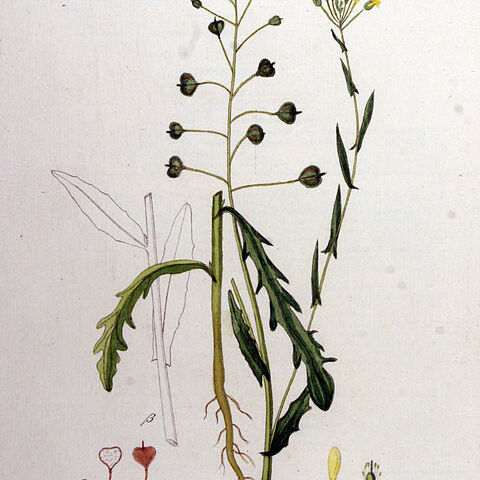Annual slender herb, 15–70 cm. high.. Stem erect, with a few ascending to erect branches, glabrous or in lower parts usually with sparse mostly branched hairs.. Lower cauline leaves spathulate in outline, deeply incised, up to 70 mm. long and 10 mm. broad, sparsely puberulent; median and upper cauline leaves ± erect, sagittate, distally dentate to subentire, 10–60 mm. long, 1.5–6 mm. broad.. Racemes loosely corymbiform, with many small flowers; in fruit very lax and short, with 15–30 mm. long ± spreading pedicels.. Sepals oblong, 2–3 mm. long.. Petals pale yellow, 4–5 mm. long, 0.8–1.2 mm. broad.. Silicula broadly pyriform, with flattened apex, 6–8 mm. long (excluding style), 4–7 mm. broad; valves strongly convex, cartilaginous but not woody; style subulate, 1.5–2 mm. long.. Seeds dark brown, minutely papillose, 1.5–2.5 mm. long, ± 1 mm. broad.. Fig. 24, p. 67.
Erect annual herb. Stems 30-40-(60) cm tall, with sparse to quite dense stellate hairs mixed with a few simple hairs, becoming glabrous above. Lower lvs clothed in stellate hairs, usually with a few simple hairs as well, narrowly obovate to oblanceolate, toothed to sinuate to pinnatifid, 2-7 cm long; upper lvs smaller, sparsely stellate-hairy, narrow-lanceolate, usually entire, auriculate at base. Racemes erect; pedicels spreading, 1.5-2-(2.5) cm long. Sepals 2-3 × 0.5-0.8 mm, with sparse long simple hairs. Petals pale yellow, narrow-spathulate, 3-4 × c. 1 mm. Stamens slightly < petals. Silicles obovoid, truncate or slightly retuse at apex, 7-10 × 6-8 mm; style persistent, 1-3 mm long; valves olive green at maturity. Seeds 2-2.5 mm long.
Erect, slender herb to 80 cm tall, sparingly branched, slightly hirsute; hairs simple and stellate; odour foetid. Leaves cauline, oblong to lanceolate, sinuate-pinnatifid to dentate, petiolate; petioles winged, auriculate. Sepals 3–4 mm long. Petals 4–6 mm long, pale yellow. Style 1–1.5 mm long. Silicula obovoid, 6–12 mm long, 8 mm wide, truncate to emarginate, compressed parallel to septum; valves convex, thin, olive-green when ripe; pedicels spreading to flexuose, 15–40 mm long. Seeds orbicular, to 2.5 mm long. Radicle accumbent.
A European sp. with lobed or deeply toothed lvs, lax racemes, and depressed-globose frs 6–10 mm, is casually intr. in s. Can. (C. dentata)

